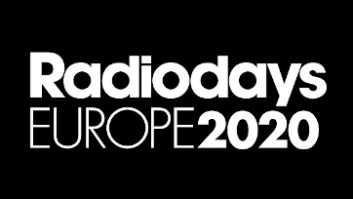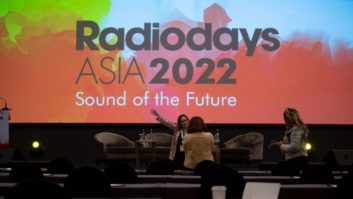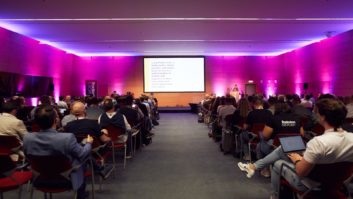
Jonty Usborne, station manager, University Radio Bath (U.K.),
speaks about his “responsive radio” platform. Photo by Conor McCabe
MILAN — The sixth edition of RadioDays Europe took place in Milan March 15–17. The event, which attracted some 1,300 people from 60 countries to the Milan Congress Center, featured more than 50 sessions and workshops as well as a technical exhibition.
Sunday, March 15, was dedicated to master classes, which delved into topics about radio talents’ branding capability, social media, creativity management (with case studies of Google and Pixar) and business-to-business radio sales.
Monday and Tuesday offered a host of sessions, running parallel on four different tracks. The theme of this year’s conference was “Passion Meets Progress,” and the content of the various sessions provided variously-graded answers to one underlying question: What is radio’s future?
The various speakers did not picture futuristic, theoretical recipes. Instead, they engaged the audience with real-life stories from radio stations, talents and content producers, telling about specific, different ways through which stations or programs tried to address the modern challenges and to manage their future.

Cajsa Lindberg, Sverige Radio P3 controller, shows
P3’s news clip on the Syrian affair to the audience.
FUTURE AUDIENCE
Station managers continue to puzzle over effective ways to attract young audiences and now with the massive diffusion of social media and connected devices, the game has become even tougher.
At Radiodays 2015, many presenters offered examples of ways in which their stations are successful in reaching younger audiences. Jonty Usborne, station manager of University Radio Bath in the United Kingdom, spoke about his “responsive radio” platform during the event.
“Our music selection is dynamically influenced by our listeners at all times. We have our listeners log in with Facebook, so we know who they are,” he said. “We know their profile and create the playlist according to who is on line. We have had great feedback and it costs us nothing.” Usborne thinks this will not replace the on-air talent, but that it’s a great help to keep listening to people and giving them what they want. “It’s about listener attention,” he added.
Sverige Radio recently involved its audience in a long interactive process of how to reshape its services to make the channel more relevant for teenagers.
“The more we looked at the results, the more we were surprised. Teenagers asked for more documentary content and for more Swedish independent music,” said Cajsa Lindberg, Sverige Radio P3 controller. “News can be boring, but they want to be updated.”

Michael Hill, managing director, Radioplayer (U.K.),
discusses “one click radio” at Radiodays 2015.
CONNECTED, TECHNOLOGIES
P3 now produces and posts on the P3 Nyheter Facebook page short video clips where headline affairs are told through simple, effective animations, capable of visualizing the numbers and the facts of each story, starting from the background.
Also during the event, Michael Hill, managing director of Radioplayer UK, emphasized the need for simplicity and functionality. “Most people say radio should look like an app. An appealing look matters, but in my opinion it’s not enough,” he said.
“Radio stations have always been one click away” from their listener, just turn the receiver on and you can hear it. “App-like radio has to be the same — one click is good, two clicks are too much and listeners will go away.”
Hill showed several available radio receiver and car radio interfaces to the audience, pointing out that even modern-looking radio interfaces do not usually comply with his “one-click” theory.
“If the listeners have to first select between AM, FM, IP or digital, it is too much — they shouldn’t have to be concerned with the technology with which the content flows,” said Hill, reminding the audience that basically any listener chooses the station. “Listeners are aware of the various stations brands, so we must present them with a list of available stations whenever possible through logos, and let the radio handle the most appropriate way to source associated content through the best available path,” he added.
Mobile receivers would then be capable of seamlessly swapping across the various delivery paths (FM, digital radio or IP) according to the best deliverable experience for the listener.
Car radios will eventually be replaced by multiple technology multimedia devices as in-car Internet connection increasingly becomes standard in new automobiles. Station managers are developing specific content and features capable of taking full advantage of data connection that will soon become widely available in many cars. This will enhance the driver’s experience and in turn increase their engagement.
Radiodays 2016 will be held next year in Paris, March 13–15, 2016.
Davide Moro reports on the industry for Radio World from Bergamo, Italy.












